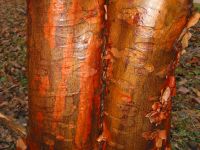paperbark maple - Acer griseum
English name:
paperbark maple
Scientific name:
Acer griseum
Family:
Aceraceae (Acer)
Height:
reported up to 10 M in Denmark (85 year old tree)
Flowering:
Inconspicuous, visible at same time as new leaves in spring
Range:
Central China Hubei, Hanan, Saanxi, Gansu & east Sichuan
 |
 |
 |
Plant description:
The 56 year-old paperbark maple in the photograph is found south of the Arboretums main road in the maple collection in square 1611 position 110.
The peeling copper-red bark of this maple makes it easy to identify. The striking bark is a wonderful element in the winter garden. Furthermore the excellent autumn colour of the leaves contrasts remarkably well against the bark and blue sky on sunny autumn days. The paper bark maple has been described as one of the five best maples for the garden. The slow growth and low maintenance makes it an ideal tree for smaller gardens. It only throws moderate shade and thus could be usefully as a companion to many smaller plants. Unfortunately the germination rate of the seed is normally less that 5 % and it is difficult to get cuttings to root, which has made it one of the more difficult trees to obtain in Denmark.
Acer griseum was introduced from China to Europe in 1901. In the wild it occurs in mixed forests as an understory tree. The oldest of the 9 trees in our collections is in the Forest Botanic Garden in Charlottenlund, was acquired in 1929 from Hilliers Nursery in England.
Crown upright becoming domed in older trees. Bark unmistakeable with thin, peeling, red-brown or copper coloured flakes or sheets, revealing cinnamon-orange bark beneath. Buds conic and in opposite pairs, shoots develop the peeling bark when 3 to 5 years old. Leaves trifoliate10 x 14 cm. Leaflets with acute tips. Terminal leaflet with a wedge shaped base, and one pair of large teeth. Side leaflets asymmetric at base. Petioles round, pink and hairy. Leaves can be orange or red coloured when unfolding and brilliant crimson, red or orange in the autumn. Nutlet hairy, with a very thick case, and nearly parallel sided wings.
References:
Mitchell, A. & Ødum S. . 1983. Træer i Nordeuropa. Gads forlag, Copenhagen, pp. 354-355.
Rushforth, K. 1999. Trees of Britain and Europe. Harper Collins Publisher. Pp 1135-1136
van Gelderen, D.M., de Jong, P.C. & Oterdoom, H.J. 1994. Maples of the World. Timber Press, Portland Oregon pp. pp204-205.
